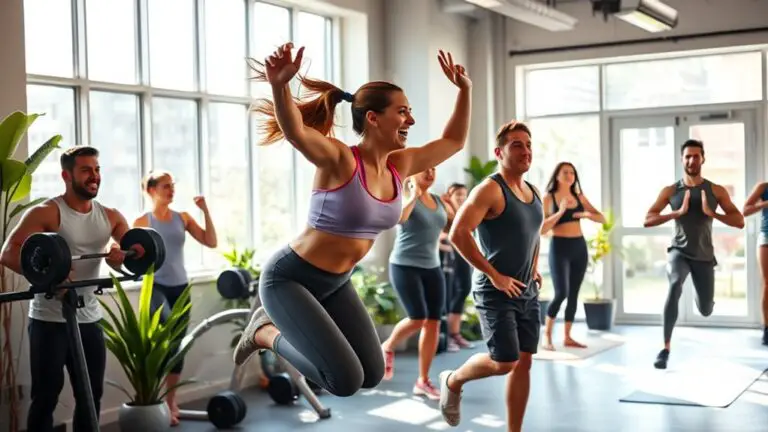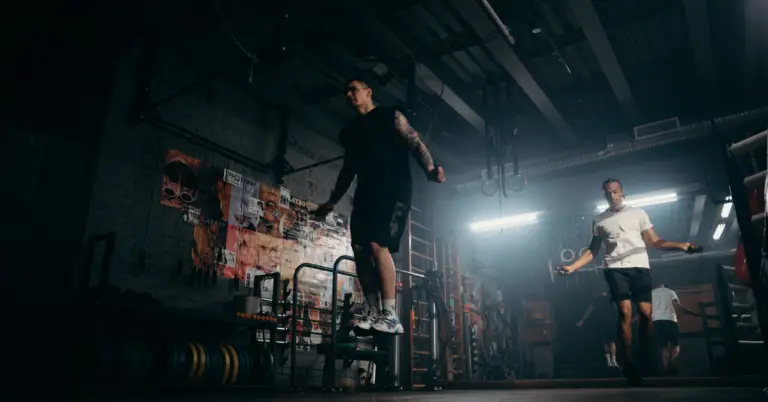The Best Gym Exercises for Improving Flexibility
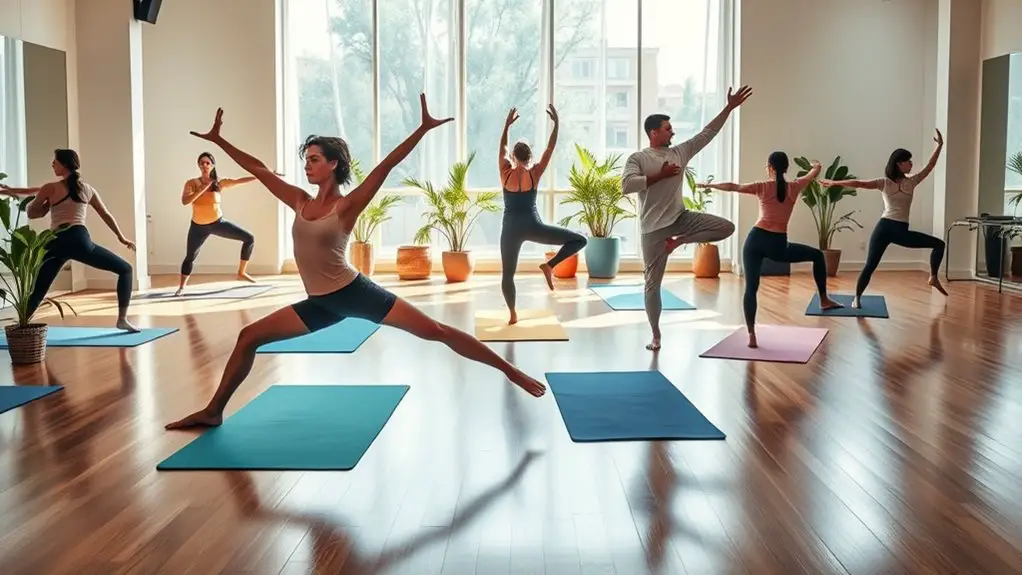
To improve your flexibility, incorporate dynamic stretching warm-ups and key exercises into your gym routine. Try the Standing Quadriceps Stretch, Seated Forward Bend, and Butterfly Stretch to target tight muscles. Lunge With a Twist can enhance core stability, while Cat-Cow and Pigeon Pose focus on the hips and spine. Don’t forget the Wall Calf Stretch to loosen your calves. Foam rolling can also aid recovery. Want to learn more effective stretches? Let’s explore some specialized techniques together!
Dynamic Stretching Warm-ups
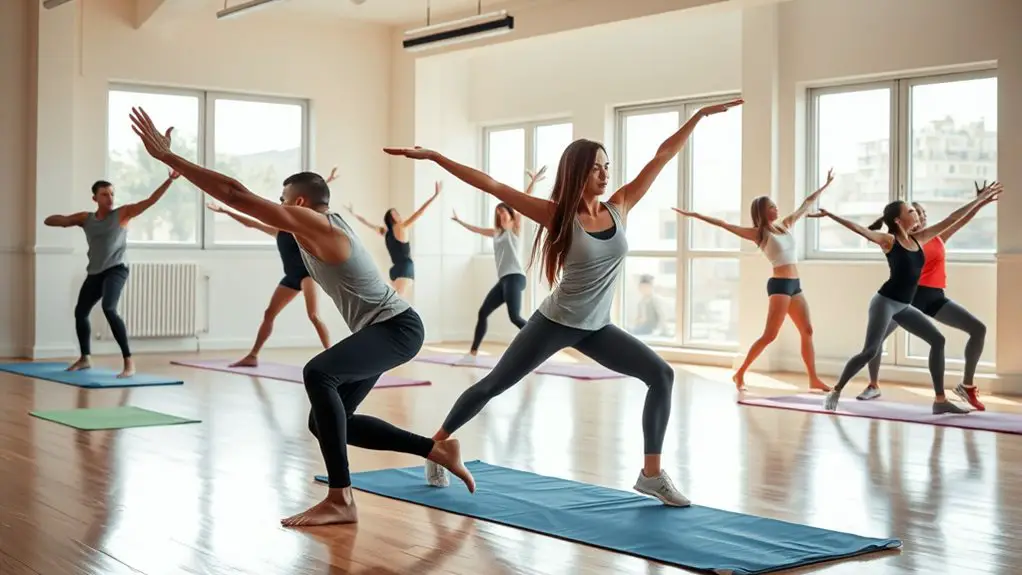
Before you plunge into your workout, it’s essential to engage in dynamic stretching warm-ups, as they not only prepare your muscles but also enhance your flexibility. Dynamic warm-ups, unlike static stretches, involve moving through a range of motion, which helps increase blood flow and elevate your heart rate. This not only primes your body for the physical demands ahead but also offers significant flexibility benefits.
Incorporating exercises like leg swings, arm circles, and torso twists into your routine can make a noticeable difference. These movements activate your muscles and joints, reducing the risk of injury while improving your overall performance. Plus, they can help your body adapt to various activities, enhancing your range of motion over time. Additionally, stretching at home can be an effective way to warm up before heading to the gym. So, don’t skip this critical step; prioritize dynamic warm-ups to maximize your workout and enjoy the flexibility benefits that come with it. Your body will thank you!
Standing Quadriceps Stretch
The Standing Quadriceps Stretch is a fantastic way to improve flexibility in your thighs and hips. To get the most out of this stretch, it’s essential to use the proper technique and be aware of common mistakes that can limit its effectiveness. Let’s explore the benefits and how to execute this stretch correctly for best results.
Benefits of Quadriceps Stretch
Although many people focus on strength training, incorporating the standing quadriceps stretch into your routine can greatly enhance your flexibility and overall performance. The quadriceps benefits are numerous, and understanding the stretching importance can motivate you to include this exercise regularly. Here are four key advantages of the standing quadriceps stretch:
- Improves Flexibility: Enhances your range of motion in the hips and knees.
- Reduces Injury Risk: Loosening tight muscles can help prevent strains and sprains.
- Enhances Athletic Performance: Better flexibility can lead to improved speed and agility.
- Promotes Muscle Recovery: Aids in relieving tension after workouts, helping your muscles recover faster.
Incorporating this stretch will make a significant difference in your fitness journey!
Proper Stretching Technique
To fully reap the benefits of the standing quadriceps stretch, mastering the proper technique is key. Begin by standing tall with your feet hip-width apart. Bend one knee, bringing your heel towards your glutes. Grab your ankle with the same-side hand, keeping your knees close together. Maintain a straight posture, engaging your core for stability. Hold the stretch for 15-30 seconds, breathing deeply. Remember, static stretching is most effective when done after your workout, as it helps improve flexibility and reduces injury risk. Don’t fall for flexibility myths—stretching shouldn’t cause pain. Listen to your body; if you feel discomfort, ease off. Consistent practice will lead to greater flexibility and mobility, enhancing your overall fitness journey.
Common Mistakes to Avoid
While stretching your quadriceps can greatly boost your flexibility, it’s easy to make mistakes that can hinder your progress or even lead to injury. To guarantee you’re getting the most out of your standing quadriceps stretch, avoid these common pitfalls:
- Overstretching Risks: Pushing too hard can cause muscle strains. Listen to your body and stretch within your limits.
- Incorrect Posture: Keep your back straight and avoid leaning forward; this guarantees you’re targeting the right muscles.
- Holding Your Breath: Breathe deeply throughout the stretch to promote relaxation and effectiveness.
- Neglecting Warm-up: Always warm up before stretching to prepare your muscles and reduce injury risks.
Seated Forward Bend
The Seated Forward Bend is a fantastic way to enhance your flexibility while also calming your mind. By mastering the proper technique, you can reap numerous benefits, including improved posture and relief from tension. Let’s explore how to perform this exercise effectively and make the most of its advantages.
Benefits of Seated Forward Bend
Seated Forward Bend is a powerful stretch that offers a multitude of benefits for your body and mind. Incorporating this stretch into your routine can lead to several seated benefits and forward advantages, including:
- Improved Flexibility: It enhances your hamstring and lower back flexibility, making daily movements easier.
- Stress Relief: This stretch calms the mind, helping reduce anxiety and promoting relaxation.
- Enhanced Posture: Regular practice encourages proper spinal alignment, combating slouching tendencies.
- Increased Circulation: It boosts blood flow to your legs and lower back, promoting overall wellness.
Proper Technique Overview
Mastering the Seated Forward Bend requires just a few simple steps to guarantee you’re getting the most out of the stretch. Begin by sitting on the floor with your legs extended straight in front of you. Keep your back straight and shoulders relaxed. Inhale deeply, then as you exhale, hinge at your hips and reach towards your toes. Remember, it’s important to avoid rounding your back. Hold this position for 20-30 seconds, feeling the stretch in your hamstrings and lower back. To maximize flexibility benefits, incorporate this stretch into your routine at least three times a week. Consistent stretching frequency will enhance your flexibility and promote overall well-being, so don’t hesitate to make this a regular part of your fitness journey!
Butterfly Stretch
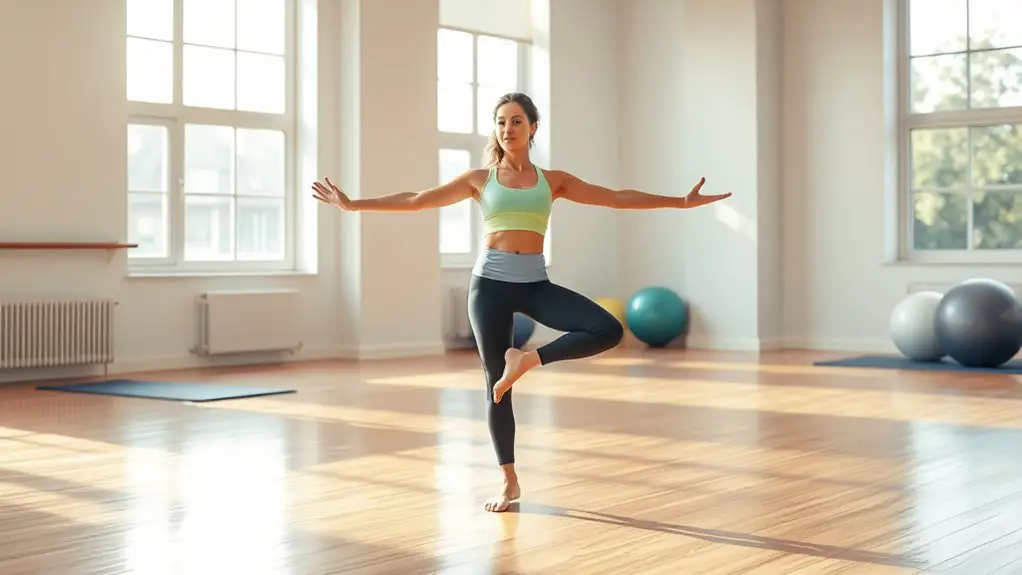
Five minutes of the butterfly stretch can greatly enhance your flexibility and hip mobility. This simple yet effective pose opens up the hips, making it a must-try for anyone looking to improve their overall flexibility. Here’s how to do it:
- Sit on the floor with your back straight and legs extended in front of you.
- Bend your knees and bring the soles of your feet together, allowing your knees to fall out to the sides.
- Hold your feet with your hands and gently press your knees toward the floor for a deeper stretch.
- Breathe deeply and hold the position for at least 30 seconds, focusing on relaxing your hips.
Incorporating the butterfly pose into your routine will not only boost your hip flexibility but also enhance your overall performance in other exercises. So, give it a try—you’ll feel the benefits!
Lunge With a Twist
While many exercises focus solely on strength or endurance, incorporating the lunge with a twist into your routine can greatly enhance your flexibility and core stability. This dynamic movement engages multiple muscle groups, improves twist mechanics, and adds variety to your lunge variations. Here’s a simple way to integrate it into your workout:
| Step | Action | Focus |
|---|---|---|
| 1. Start | Step forward into a lunge | Balance & strength |
| 2. Twist | Rotate your torso toward the front leg | Core engagement |
| 3. Hold | Maintain the twist for a few seconds | Flexibility |
| 4. Return | Step back to the starting position | Control & stability |
Cat-Cow Stretch
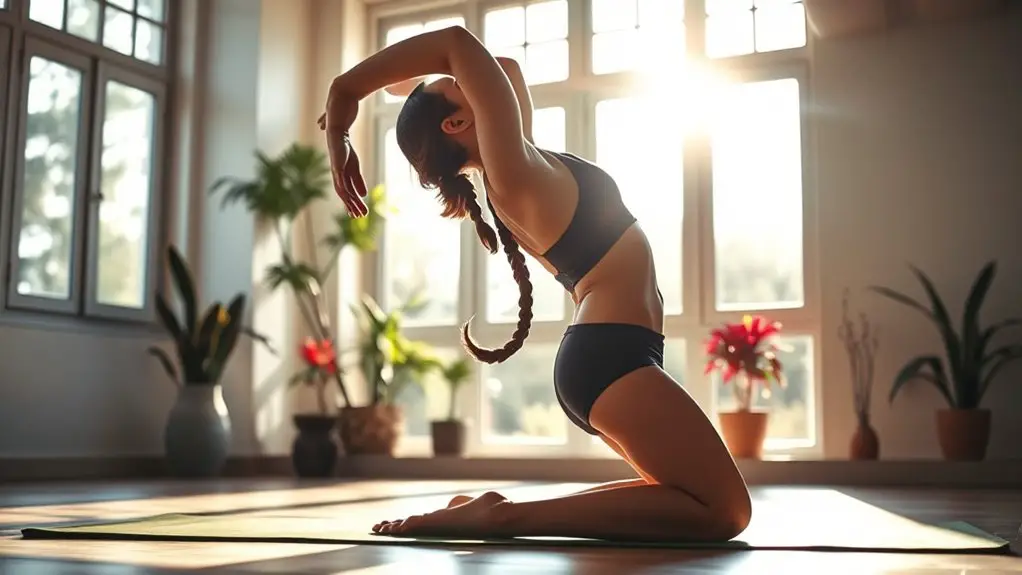
If you’re looking to enhance your flexibility and relieve tension in your back, the Cat-Cow stretch is an excellent addition to your routine. This dynamic movement not only promotes spinal alignment but also helps you connect your breath with your body. Here’s how to perform the Cat-Cow stretch effectively:
- Start on all fours: Place your hands under your shoulders and knees under your hips.
- Inhale and arch your back: Drop your belly towards the floor while lifting your head and tailbone—this is the Cow position.
- Exhale and round your spine: Tuck your chin and tailbone while pulling your belly button towards your spine—this is the Cat position.
- Repeat for several cycles: Explore cat cow variations to deepen your practice.
Incorporating this stretch regularly can improve your overall flexibility and help you feel more centered. Remember, consistency is key!
Pigeon Pose
Although it may seem challenging at first, incorporating Pigeon Pose into your routine can greatly enhance your hip flexibility and relieve tightness in the lower body. This pose is fantastic for releasing tension in the hips and glutes, making it a favorite among those who sit for long periods. To get the most out of Pigeon Pose, focus on your breath and hold the position for at least 30 seconds.
If you find the traditional pose tough, try some Pigeon Pose variations. For example, the Reclined Pigeon Pose offers a gentler alternative, allowing you to stretch while lying on your back. Alternatively, the King Pigeon Pose adds a backbend, deepening the stretch for advanced practitioners. By exploring these variations, you can tailor your practice to match your flexibility level. Remember, consistency is key! Embrace Pigeon Pose and its benefits, and watch your flexibility improve over time.
Wall Calf Stretch
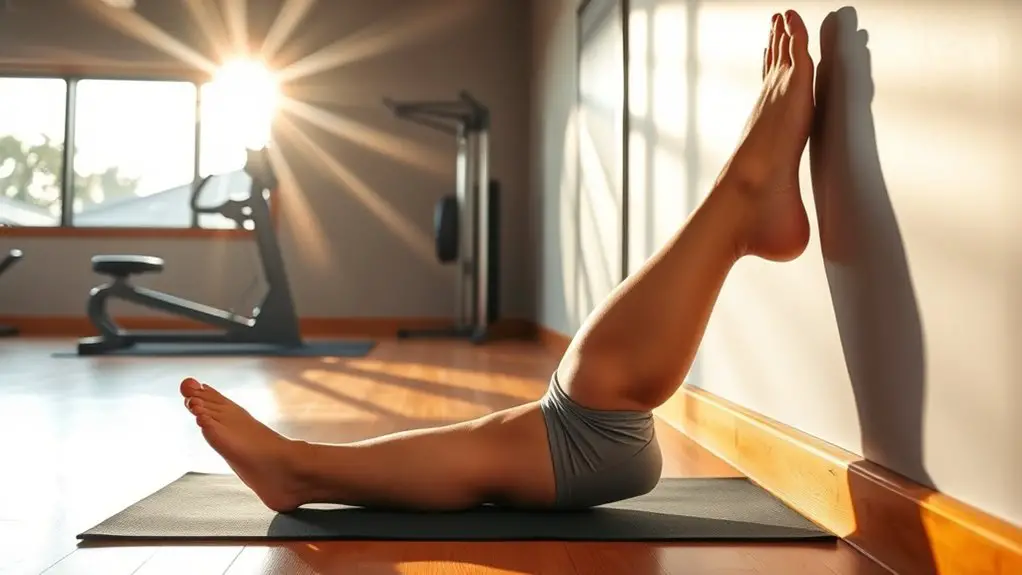
After working on your hip flexibility with Pigeon Pose, it’s time to give your calves some attention. The Wall Calf Stretch is an excellent way to enhance your calf muscle anatomy, targeting both the gastrocnemius and soleus muscles. This stretch not only improves flexibility but also reduces the risk of injury during workouts.
Here’s how to do it:
- Stand facing a wall, placing your hands on it at shoulder height.
- Step one foot back, keeping it straight, and bend the front knee.
- Press your back heel into the ground while feeling the stretch in your calf.
- Hold the stretch for 15-30 seconds, then switch sides.
Incorporating this stretch into your routine can lead to significant flexibility benefits, making you more agile and enhancing your overall performance. Make it a part of your post-workout regimen, and your calves will thank you!
Foam Rolling Techniques
Foam rolling is a game-changer for improving flexibility and reducing muscle tension. By using a foam roller, you can enhance your self myofascial release technique, helping to break down knots and tightness in your muscles. Start by rolling slowly over tight areas—spend more time on spots that feel particularly sore. Focus on major muscle groups like your quads, hamstrings, and back.
You’ll experience foam roller benefits such as increased blood flow, improved range of motion, and faster recovery times. Incorporate rolling into your warm-up or cool-down routine for maximum effect. Remember, it shouldn’t hurt excessively; if it does, ease up.
Aim for 1-2 minutes on each muscle group, and don’t forget to breathe deeply while you roll. With consistency, you’ll notice a significant improvement in your flexibility and overall performance. So grab that foam roller and get rolling!
Frequently Asked Questions
How Often Should I Perform Flexibility Exercises Each Week?
To improve your flexibility, it’s recommended you perform flexibility routines at least two to three times a week. This weekly frequency allows your muscles and joints to adapt and gradually increase their range of motion. You don’t have to spend hours; even 15-30 minutes per session can be effective. Consistency is key, so find a time that works for you, and stick to it. You’ll notice improvements in no time, making it worth the effort!
Can I Improve Flexibility Without Going to the Gym?
Sure, you don’t need a gym to become as flexible as a pretzel at a yoga convention! You can absolutely improve your flexibility with home workouts and yoga routines. Think of it as your personal stretch party, where you’re the star. Just dedicate some time each week to stretch, practice poses, and breathe deeply. You’ll feel more limber in no time, proving that home can be just as effective as any gym.
What Is the Best Time of Day for Stretching?
The best time for stretching really depends on your schedule and preferences. Morning stretches can help wake up your body, boost your energy, and set a positive tone for the day. On the other hand, incorporating evening routines can help you unwind, relieve tension, and prepare for a restful night. Experiment with both times to see what feels best for you, and remember that consistency is key to improving your flexibility over time!
Are There Any Injuries That Prevent Stretching?
Yes, certain injuries can prevent you from stretching effectively. If you’ve got a recent injury, it’s vital to prioritize recovery and consult a healthcare professional before attempting any stretching techniques. Stretching can aid in injury prevention, but it’s essential to listen to your body. Focus on gentle movements that don’t aggravate your injury, and gradually work on flexibility as you heal. Staying motivated and patient will help you regain your range of motion safely.
How Long Should Each Stretch Be Held for Optimal Results?
To achieve ideal flexibility, aim to hold each stretch for about 15 to 30 seconds. This duration allows your muscles to relax and lengthen effectively. Don’t rush it—focus on your breathing and listen to your body. If you can, repeat the stretch 2 to 4 times for even better results. Consistency is key, so incorporate these stretches into your routine regularly, and you’ll see improvements in your flexibility over time.

